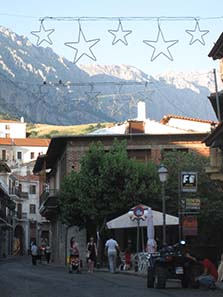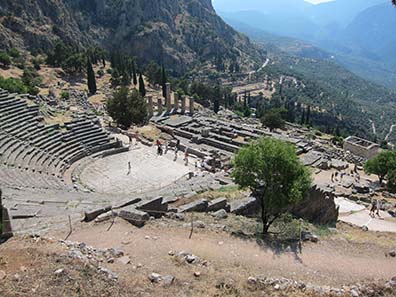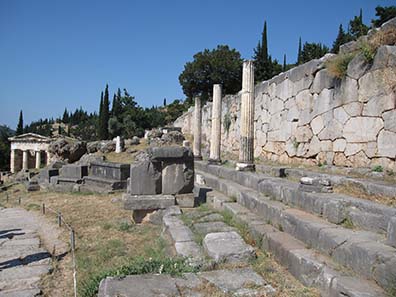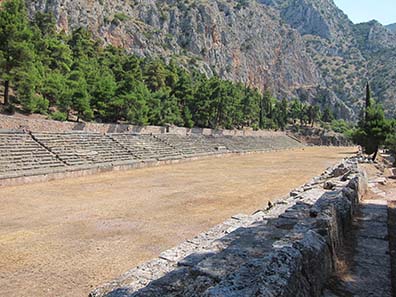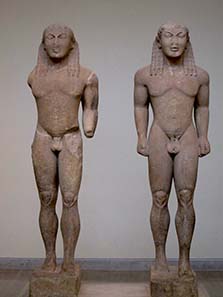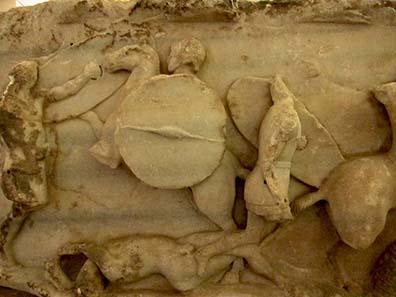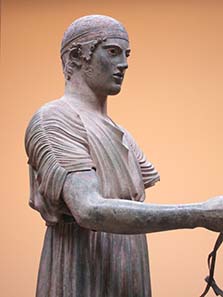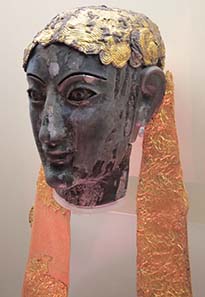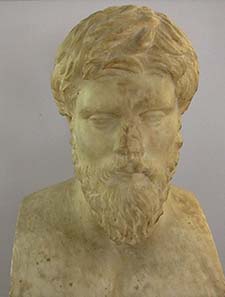by Ursula Kampmann
September 22, 2011 – The last stage of our journey throughout Greece takes us to Delphi. On our trip back, however, we were in danger of faring like Odysseus who, when heading home, was carried off course…
Day 28, July 9, 2011, Delphi
We spent a quiet night in the mountains high above Delphi. Completely exhausted and with a car that ran the risk of boiling with each little ascension, we had arrived at Arachova. At last, we had found a hotel where there was something like luxury. However, in the five-star hotel there were only one man (at the reception) and one woman working (for cleaning the house). Admittedly, it didn’t take many more people: only two rooms were occupied in the entire bunker.
In Greece, Christmas decoration is on display all year round. Photograph: KW.
It seems that Arachova was considered ancient Anemoreia from time to time – that, however, couldn’t be confirmed by archaeological finds yet. What is certain is that the city played a decisive role during the Greek wars of independence. It was here where Georgios Karaiskakis defeated an army in 1826 and erected a pyramid out of the heads of the ones killed.
Nothing of that is still present in modern Arachova. In summer, the small community (with its population of approximately 4,000 people) is deserted. In winter, by contrast, Arachova is a vibrant place, a center for skiers, who put their ability on the test on the Parnassus. Our hotelier had a showcase full of prize cups he and his sister had won in skiing contests. Our room would have cost 450 Euros in winter (only to avoid any misunderstanding: only a fraction of that was charged for the summer quarter).
Delphi – view from the theater to temple and treasuries. Photograph: KW.
What can I say about Delphi? Anything I could say in three chapters everyone knows already or can look up with Wikipedia. The history of the sanctuary and, most of all, the habits accompanying the oracle of Pythia, I will describe in detail elsewhere.
Delphi. Tridrachm, around 475. Two rhyta, two dolphins above. Rev. Ceiling of a temple, dolphin and laurel wreath within. From auction Leu Numismatik AG 81 (2001), 199.
Let us stick with actual Delphi which vaulted us right in the world of tourism. The perceived number of tourists present was several thousand. There was even a queue at the ticket box where the entrance fee to the excavation had to be paid. That was an entirely new experience, at least in this holiday. Until now, we had been all by ourselves at all ancient sites, being quite peaceful.
Athenian Treasury – please note the absence of any people. Photograph: KW.
Soon we stood in front of the Athenian Treasury and got annoyed at the tourists running in our picture again and again. It took me half an hour or so to finally catch the moment when no one was standing in front of this magnificent building. We heard the travel guides praising the beauty of Delphi in many languages. They were followed by a flock of tourists which, due to the steep ascent, divided into the light-hearted and eager ones and the ones who were annoyed and bored.
On the wall of the temple endless inscriptions can be found. Photograph: KW.
Everywhere in Delphi one comes across any number of inscriptions, which reminds me of a story too good to be bitten back. It is about an epigraphist who never got tired of inscriptions.
Carl Otfried Mueller (*1797 in Silesia) was a Classical scholar of the 19th century: he was historian, philologist, archaeologist, epigraphist and numismatist, all at the same time. He ranged amongst the most known scholars in Germany when he departed for Sicily and Greece in 1839. It is easy to imagine in what mood he got when he came across all the unpublished inscriptions lying around in Delphi. Legend has it that Mueller, when discovering a lengthy inscription incorporated into a wall upside down, told his two friends to rope him down: with his feet in the air in order to translate the inscription correctly. But perhaps he simply had stayed too long in the sun: be that as it may, when copying, Mueller suffered a heat stroke. He was brought to Athens, where he died a couple of days later. What a fate! Albeit not recommended for imitation.
Stadium of Delphi. Photograph: KW.
Heat stroke! To be honest, upon ascending the way to the stadium, I imagined vividly how Müller must have felt. On the other hand, there was a historical site alluring. In front of us a woman teacher herded an entire flock of grumpy boarders from Russia whose colored t-shirts stated the name of their school. Finally we arrived at the stadium, together with 200 other tourists, at the most. And that was a problem because the stadium is closed off by now. At the farest end there is a spot where it is possible to look into the stadium when squeezing onto the wall, which is a bit lower there. That was exactly what roughly 200 people were trying – with a foreseeable result. The picture was made when I extended my arm to the left. My photograph saw much more of the stadium than I did. Next time you are visiting Delphi you can skip the ascent. It isn’t worth it (anymore).
Kleobis and Biton. Photograph: KW.
In contrast to the superb museum of Delphi. By all means, you must see it. It ranges amongst the most beautiful Greece has to offer. I am not even referring to such famous statues like the masterpiece of Polymides from Argos, Kleobis and Biton. Their mother is said to have prayed to the gods to give them the best gift they could give. Consequently, Hera instantaneously sent them a peaceful death.
Odysseus undernath a ram. Photograph: KW.
My favorite wasn’t as big as 12 cm. It was a small attachment showing Odysseus escaping from the cave of Polyphemus being tied to the underside of a ram.
Titus Quinctius Flamininus. Photograph: KW.
Of course, there was plenty for us coin fans, too. Like a portrait that was identified as depiction of Titus Quinctius Flamininus on the basis of the coin images, who proclaimed the autonomy of the Greeks at the Isthmian Games in 196 B. C.
Monument of Aemilius Paullus. Photograph: KW.
Or the monument Aemilius Paullus had built in Delphi after his victory over the Macedonians. The sides show episodes from the Battle of Pydna.
The Charioteer of Delphi. Photograph: KW.
Likewise the Charioteer of Delphi ought to be well-known from depictions on coins. He (or a colleague of his) is shown on the obverses of the coinage from Gela dating to the same period of time (albeit with the chariot there). The tyrant of Gela, Polyzalos, who rose to power in 478, commissioned a monument of the victorious quadriga after the chariot race. Only the charioteer survived because he was buried in a landslide and thus wasn’t been melted down – like many other statues – for the production of weapons.
Remains of a statue made of gold and ivory. Photograph: KW.
At the sight of the pale marble it is hard to envision the composite statues of antiquity. Good thing is that the heads of a few Archaic statues made of gold and ivory have been preserved. Although the original colors are barely visible anymore, the variety of materials is indicative of antiquity not being Classic, but rich in color and tawdrily.
Portrait of Plutarch. Photograph: KW.
I almost forgot to mention Plutarch. The Museum of Delphi displays a portrait of him that might in fact be associated with him. Let us take the opportunity at this point to thank those who, in the Renaissance, had made antiquity known famous in Europe. The Parallel Lives of Plutarch shaped the perception of antiquity of millions of people (and they still do it – that is what I think when reading the comments on my articles which are a bit cheeky from time to time).
Plutarch was born in Chaironea and lived from A. D. 45 or so until 125. He spent the bigger part of his life at home and held a number of offices there. He was one of the priests of Apollo at Delphi, for instance.
Castalian Spring. Photograph: KW.
Outside the sanctuary one passes the Castalian Spring. The name recalls one of the many forced romances of Apollo. This nymph, for a change, didn’t transform into a laurel tree but threw herself into the spring before Apollo could rape her. The Castalian Spring played an important role for pilgrims in the ritual cleansing before entering the sanctuary.
Sanctuary of Athena. Photograph: KW.
As the Sicilian saying has it: only donkeys and Englishmen lie down in the sun at noon. We didn’t want to fall into this category and thus just looked at the Sanctuary of Athena from above. Like 99.9 % of all visitors of Delphi, by the way. While the paths of the sanctuary are as crowded as a pedestrian zone during a closing sale, the Sanctuary of Athena is empty. And that is a pity for there are temples, treasuries and a graceful tholos. That takes us to the end of the photographs but I don’t want to miss the opportunity to describe our eventful trip back home during which, incidentally, we experienced the very first day of the new port of Patras.
Day 30, July 11, 2011 – Greek organisation
We were early birds on the day of our departure. After all, we feared that our car would let us down (actually, in order for the engine to cool down again, we stopped for the same period of time it had taken us to go the 125 km from Delphi to Patras). Hence, we sat in the air-conditioned waiting hall of the port as early as 3 p. m. and intended to read until the departure of the ship just before midnight and recover from the strains of the ride. The ship that was going to bring us back to Venice lay directly in front of us.
Admittedly, I became panicky when the ship left its berth around 6 p. m. In addition, not a single counter was open. Information? In Greek view, that was something for weaklings. At any rate, the information desk likewise was unstaffed.
We decided to look for the port entry for cars. It was still broiling when we started. 10 minutes, half an hour, three-quarters of an hour, and still no entry. Eventually, we discovered a whole in the fence and slipped through. Now, we had entered the port area which was an information-free zone, just like the passenger terminal. After another walk we saw a kind of policeman. Did he speak English? Well, a little bit. Where was the entry for cars? Oh, we were completely in the wrong place, for this was the old port! We had to drive to the new port, 8 km straight ahead.
Good lord, we felt stupid. We consequently took our car, drove to the new port and got into a total mess. Well, not really, because there was a lot going on. We were still quite early. Chaotic was rather the track guidance that didn’t give a hint as to which one we had to take. At some point I hit on the clever idea to take the one that was guarded by a man. If we were wrong he would point us in the right direction. We were wrong and he pointed us in a direction. Where did we have to go? He didn’t speak any English but his gesture evidently pointed in a different direction. Hence we made use of the swarm intelligence and parked where most of the other cars did. Very clever! In fact, here was the agency situated where we could reconfirm our tickets for the ferry. For 20 minutes I stood in front of the desk, all alone, while the lady at the desk eagerly looked for the philosopher’s stone in her computer. Finally my attempts to get her attention were successful. Haughtily she looked at me and told me to be patient, for that was the very first day the port was in use.
Now, I didn’t feel so stupid anymore. The Greeks relocated their port not ages ago but on that very day – of course without telling the tourists anything about it. Why should they? The bigger part of the tourists were Germans.
I vividly remember an incident in Cambodia when I went bright red with shame. We were stuck in the swamp with our shallow boats. Locals pulled us out of the mud every few minutes. In this situation a (German) fellow passenger assumed command. Naturally, he wasn’t successful in getting the boats to move but all members of the international tour group laughed at “the German” feeling responsible straightaway.
This was nothing different. Albeit no one was laughing. An informal emergency committee was formed that made sure that a tourist, who spoke several languages, stayed at the old port to inform fellow passengers about the relocation. Another one had his car keys and took his car onto the ferry while he waited until the last moment to guide all the lost souls to the right place. I don’t know if all reached the ferry. I think it possible though not thanks to the Greek organisation. Rumour had it later on that there had been a photocopied piece of paper, written in English, which used to lie on the table of the information but fell behind the counter at some point of time. Be that as it may. I think, this last look at the new port of Patras is a good picture of what the crisis in Greece is all about. It couldn’t be fixed with still more money. It would need a change of mentality but that cannot be achieved in such short a time.
I don’t want to insult any of my Greek friends at this point. Over the course of the month, I have met many nice, helpful, dedicated and far-seeing people. But they seem to be faced with other Greeks not willing to be efficient and act with consideration. After all, tourism isn’t merely building state-of-the-art museums but also planning the infrastructure. A tourist not only needs something to look at but likewise a nice café, a modern hotel. One might say that this doesn’t pay off precisely because no tourists come – but they don’t come because they don’t find what they are used to. A little bit more planning security in regard to opening hours, a bit more comfort with accommodation and having a meal and, most of all, more advertising would bring Greece not only the bathing tourists but also the tourists interested in culture, which are willing to spend much more money – Spain, Italy and Turkey are vying for the latter ones for many years by now.
I know it is considered coarse and typically German to raise the index finger in an informatory manner. But I love Greece! It is near and dear to me! I want this country to find its way out of this crisis and develop a flourishing tourism able to earn everyone involved a living. And I sincerely hope that my Greek friends will understand my open words in this very sense.
In any case, thank you, Greece, for the wonderful days I was permitted to spend here.
THE END
You can read all other parts of this diary here.





